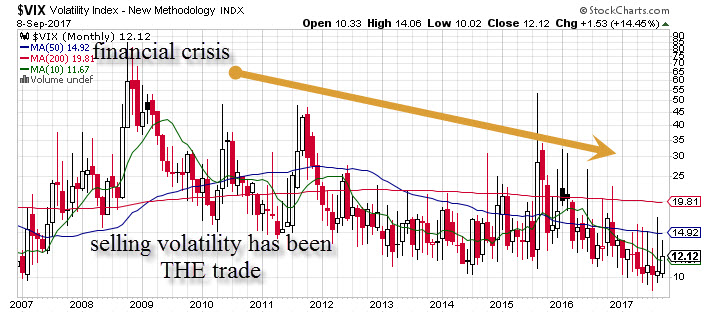Traders are trying to score big – but they’re playing a sucker’s game. The idea is to buy volatility when it’s low and wait for the ultimate move to the upside. They are dreaming of a move we haven’t seen since 2008 when volatility took off like a rocket ship into space. Back then, the VIX hit well over 90 as it appeared the world was coming to an end. If you bet long volatility, your bet failed. And your bets have continued to fail.

Copyright: argus456 / 123RF Stock Photo
Why it’s a bad idea to buy long volatility
Big spikes in volatility have been short-lived.
Case in point: Volatility spiked twice in August. They were two of the biggest percentage moves of all time, but they were starting from a low base (from 10 to 16 or so). Spikes in volatility have paid off – don’t get me wrong – but the volatility chart has clearly been trending down. Making a long volatility bet has been a loser this year, last year, and frankly since the financial crisis ended.
Note, we are not talking about buying cheap protection in case of a disastrous outcome. That remains a smart strategy, especially when options are cheap with a low VIX.
Who thinks it’s a good idea to buy long volatility? Skeptics, many of whom were critical of the Fed’s policies. They believe the end – and a surge in volatility – is coming. This has resulted in a lot of market noise, because they think the bull market has gone on far too long. It doesn’t matter what they (or we) think. We must respect the market action and sentiment, the core of which is volatility.
The VIX has shown some big moves up, but those have mostly occurred on “panic days”. Anyone seduced by the dark side of the market (aka, they are bearish) might make a few dollars when volatility rises. If they buy long volatility, though, they’ve experienced nothing but anguish.

For those who can ride volatility lower, they have earned rich rewards. I recently read about a guy who worked at Target and managed to make $12 million shorting volatility products (there are several ETN’s to choose from). He was not an experienced floor trader; he simply traded from home. Those trades were not complex or sophisticated. You just needed to mimic the trading styles used during prior patterns of volatility.













Leave A Comment